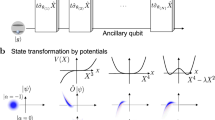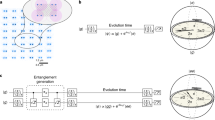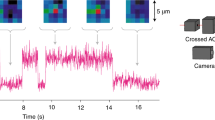Abstract
Quantum control of motion is central for modern atomic clocks1 and interferometers2. It enables protocols to process and distribute quantum information3,4, and allows the probing of entanglement in correlated states of matter5. However, the motional coherence of individual particles can be fragile to maintain, as external degrees of freedom couple strongly to the environment. Systems in nature with robust motional coherence instead often involve pairs of particles, from the electrons in helium, to atom pairs6, molecules7 and Cooper pairs. Here we demonstrate long-lived motional coherence and entanglement of pairs of fermionic atoms in an optical lattice array. The common and relative motion of each pair realize a robust qubit, protected by exchange symmetry. The energy difference between the two motional states is set by the atomic recoil energy, is dependent on only the mass and the lattice wavelength, and is insensitive to the noise of the confining potential. We observe quantum coherence beyond ten seconds. Modulation of the interactions between the atoms provides universal control of the motional qubit. The methods presented here will enable coherently programmable quantum simulators of many-fermion systems8, precision metrology based on atom pairs and molecules9,10 and, by implementing further advances11,12,13, digital quantum computation using fermion pairs14.
This is a preview of subscription content, access via your institution
Access options
Access Nature and 54 other Nature Portfolio journals
Get Nature+, our best-value online-access subscription
$29.99 / 30 days
cancel any time
Subscribe to this journal
Receive 51 print issues and online access
$199.00 per year
only $3.90 per issue
Buy this article
- Purchase on Springer Link
- Instant access to full article PDF
Prices may be subject to local taxes which are calculated during checkout




Similar content being viewed by others
Data availability
The data that support the findings of this study are available from the corresponding authors upon reasonable request. Source data are provided with this paper.
References
Ludlow, A. D., Boyd, M. M., Ye, J., Peik, E. & Schmidt, P. O. Optical atomic clocks. Rev. Mod. Phys. 87, 637–701 (2015).
Xu, V. et al. Probing gravity by holding atoms for 20 seconds. Science 366, 745–749 (2019).
Jaksch, D., Briegel, H.-J., Cirac, J. I., Gardiner, C. W. & Zoller, P. Entanglement of atoms via cold controlled collisions. Phys. Rev. Lett. 82, 1975–1978 (1999).
Duan, L.-M., Lukin, M. D., Cirac, J. I. & Zoller, P. Long-distance quantum communication with atomic ensembles and linear optics. Nature 414, 413–418 (2001).
Islam, R. et al. Measuring entanglement entropy in a quantum many-body system. Nature 528, 77–83 (2015).
Bergschneider, A. et al. Experimental characterization of two-particle entanglement through position and momentum correlations. Nat. Phys. 15, 640–644 (2019).
Greiner, M., Regal, C. A., Stewart, J. T. & Jin, D. S. Probing pair-correlated fermionic atoms through correlations in atom shot noise. Phys. Rev. Lett. 94, 110401 (2005).
Gross, C. & Bakr, W. S. Quantum gas microscopy for single atom and spin detection. Nat. Phys. 17, 1316–1323 (2021).
Schiller, S., Bakalov, D. & Korobov, V. I. Simplest molecules as candidates for precise optical clocks. Phys. Rev. Lett. 113, 023004 (2014).
Kondov, S. S. et al. Molecular lattice clock with long vibrational coherence. Nat. Phys. 15, 1118–1122 (2019).
Weitenberg, C. et al. Single-spin addressing in an atomic Mott insulator. Nature 471, 319–324 (2011).
Hollerith, S. et al. Quantum gas microscopy of Rydberg macrodimers. Science 364, 664–667 (2019).
Browaeys, A. & Lahaye, T. Many-body physics with individually controlled Rydberg atoms. Nat. Phys. 16, 132–142 (2020).
Mamaev, M., Thywissen, J. H. & Rey, A. M. Quantum computation toolbox for decoherence-free qubits using multi-band alkali atoms. Adv. Quantum Technol. 3, 1900132 (2020).
Bauer, B., Bravyi, S., Motta, M. & Kin-Lic Chan, G. Quantum algorithms for quantum chemistry and quantum materials science. Chem. Rev. 120, 12685–12717 (2020).
Viverit, L., Menotti, C., Calarco, T. & Smerzi, A. Efficient and robust initialization of a qubit register with fermionic atoms. Phys. Rev. Lett. 93, 110401 (2004).
Serwane, F. et al. Deterministic preparation of a tunable few-fermion system. Science 332, 336–338 (2011).
Chiu, C. S., Ji, G., Mazurenko, A., Greif, D. & Greiner, M. Quantum state engineering of a Hubbard system with ultracold fermions. Phys. Rev. Lett. 120, 243201 (2018).
Myrskog, S. H., Fox, J. K., Mitchell, M. W. & Steinberg, A. M. Quantum process tomography on vibrational states of atoms in an optical lattice. Phys. Rev. A 72, 013615 (2005).
Müller, T., Fölling, S., Widera, A. & Bloch, I. State preparation and dynamics of ultracold atoms in higher lattice orbitals. Phys. Rev. Lett. 99, 200405 (2007).
Förster, L. et al. Microwave control of atomic motion in optical lattices. Phys. Rev. Lett. 103, 233001 (2009).
Bakr, W. S. et al. Orbital excitation blockade and algorithmic cooling in quantum gases. Nature 480, 500–503 (2011).
van Frank, S. et al. Interferometry with non-classical motional states of a Bose–Einstein condensate. Nat. Commun. 5, 4009 (2014).
Kwiat, P. G., Berglund, A. J., Altepeter, J. B. & White, A. G. Experimental verification of decoherence-free subspaces. Science 290, 498–501 (2000).
Kielpinski, D. et al. A decoherence-free quantum memory using trapped ions. Science 291, 1013–1015 (2001).
Chin, C., Grimm, R., Julienne, P. & Tiesinga, E. Feshbach resonances in ultracold gases. Rev. Mod. Phys. 82, 1225–1286 (2010).
Köhl, M., Moritz, H., Stöferle, T., Günter, K. & Esslinger, T. Fermionic atoms in a three dimensional optical lattice: observing Fermi surfaces, dynamics, and interactions. Phys. Rev. Lett. 94, 080403 (2005).
Diener, R. B. & Ho, T.-L. Fermions in optical lattices swept across Feshbach resonances. Phys. Rev. Lett. 96, 010402 (2006).
Zürn, G. et al. Fermionization of two distinguishable fermions. Phys. Rev. Lett. 108, 075303 (2012).
Busch, T., Englert, B.-G., Rzażewski, K. & Wilkens, M. Two cold atoms in a harmonic trap. Found. Phys. 28, 549–559 (1998).
Idziaszek, Z. & Calarco, T. Two atoms in an anisotropic harmonic trap. Phys. Rev. A 71, 050701 (2005).
Bolda, E., Tiesinga, E. & Julienne, P. Ultracold dimer association induced by a far-off-resonance optical lattice. Phys. Rev. A 71, 033404 (2005).
Sala, S. et al. Coherent molecule formation in anharmonic potentials near confinement-induced resonances. Phys. Rev. Lett. 110, 203202 (2013).
Sala, S. & Saenz, A. Theory of inelastic confinement-induced resonances due to the coupling of center-of-mass and relative motion. Phys. Rev. A 94, 022713 (2016).
Ishmukhamedov, I. S. & Melezhik, V. S. Tunneling of two bosonic atoms from a one-dimensional anharmonic trap. Phys. Rev. A 95, 062701 (2017).
Thompson, S. T., Hodby, E. & Wieman, C. E. Ultracold molecule production via a resonant oscillating magnetic field. Phys. Rev. Lett. 95, 190404 (2005).
Hartke, T., Oreg, B., Jia, N. & Zwierlein, M. Doublon–hole correlations and fluctuation thermometry in a Fermi–Hubbard gas. Phys. Rev. Lett. 125, 113601 (2020).
Fuchs, G. D., Dobrovitski, V. V., Toyli, D. M., Heremans, F. J. & Awschalom, D. D. Gigahertz dynamics of a strongly driven single quantum spin. Science 326, 1520–1522 (2009).
Haller, E. et al. Confinement-induced resonances in low-dimensional quantum systems. Phys. Rev. Lett. 104, 153203 (2010).
Donley, E. A., Claussen, N. R., Thompson, S. T. & Wieman, C. E. Atom–molecule coherence in a Bose–Einstein condensate. Nature 417, 529–533 (2002).
Syassen, N. et al. Atom–molecule Rabi oscillations in a Mott insulator. Phys. Rev. Lett. 99, 033201 (2007).
Hartmann, S. R. & Hahn, E. L. Nuclear double resonance in the rotating frame. Phys. Rev. 128, 2042–2053 (1962).
Liu, L. R. et al. Molecular assembly of ground-state cooled single atoms. Phys. Rev. X 9, 021039 (2019).
Levine, H. et al. Parallel implementation of high-fidelity multiqubit gates with neutral atoms. Phys. Rev. Lett. 123, 170503 (2019).
Mandel, O. et al. Controlled collisions for multi-particle entanglement of optically trapped atoms. Nature 425, 937–940 (2003).
Anderlini, M. et al. Controlled exchange interaction between pairs of neutral atoms in an optical lattice. Nature 448, 452–456 (2007).
Trotzky, S. et al. Time-resolved observation and control of superexchange interactions with ultracold atoms in optical lattices. Science 319, 295–299 (2008).
Greif, D., Uehlinger, T., Jotzu, G., Tarruell, L. & Esslinger, T. Short-range quantum magnetism of ultracold fermions in an optical lattice. Science 340, 1307–1310 (2013).
Kaufman, A. M. et al. Entangling two transportable neutral atoms via local spin exchange. Nature 527, 208–211 (2015).
Rom, T. et al. State selective production of molecules in optical lattices. Phys. Rev. Lett. 93, 073002 (2004).
Greene, C. H., Dickinson, A. S. & Sadeghpour, H. R. Creation of polar and nonpolar ultra-long-range Rydberg molecules. Phys. Rev. Lett. 85, 2458–2461 (2000).
Guardado-Sanchez, E. et al. Quench dynamics of a Fermi gas with strong nonlocal interactions. Phys. Rev. X 11, 021036 (2021).
Ho, A. F. Fermions in optical lattices near a Feshbach resonance: from band insulator to Mott insulator. Phys. Rev. A 73, 061601 (2006).
Koga, A., Kawakami, N., Rice, T. M. & Sigrist, M. Orbital-selective Mott transitions in the degenerate Hubbard model. Phys. Rev. Lett. 92, 216402 (2004).
Kubo, K. Pairing symmetry in a two-orbital Hubbard model on a square lattice. Phys. Rev. B 75, 224509 (2007).
Yan, B. et al. Observation of dipolar spin-exchange interactions with lattice-confined polar molecules. Nature 501, 521–525 (2013).
Baron, J. et al. Order of magnitude smaller limit on the electric dipole moment of the electron. Science 343, 269–272 (2014).
Cairncross, W. B. et al. Precision measurement of the electron’s electric dipole moment using trapped molecular ions. Phys. Rev. Lett. 119, 153001 (2017).
Cheuk, L. W. et al. Quantum-gas microscope for fermionic atoms. Phys. Rev. Lett. 114, 193001 (2015).
Murmann, S. et al. Two fermions in a double well: exploring a fundamental building block of the Hubbard model. Phys. Rev. Lett. 114, 080402 (2015).
Mitra, D. et al. Quantum gas microscopy of an attractive Fermi–Hubbard system. Nat. Phys. 14, 173–177 (2018).
Chen, Y., Xiao, D.-W., Zhang, R. & Zhang, P. Analytical solution for the spectrum of two ultracold atoms in a completely anisotropic confinement. Phys. Rev. A 101, 053624 (2020).
D’Errico, C. et al. Feshbach resonances in ultracold 39K. New J. Phys. 9, 223–223 (2007).
Daniel, D. J. Exact solutions of Mathieu’s equation. Prog. Theor. Exp. Phys. 2020, 043A01 (2020).
Laucht, A. et al. Breaking the rotating wave approximation for a strongly driven dressed single-electron spin. Phys. Rev. B 94, 161302 (2016).
Wang, G., Liu, Y.-X. & Cappellaro, P. Observation of the high-order Mollow triplet by quantum mode control with concatenated continuous driving. Phys. Rev. A 103, 022415 (2021).
Acknowledgements
We thank C. Robens for discussions. This work was supported by the NSF through the Center for Ultracold Atoms and Grant PHY-2012110, ONR (grant number N00014-17-1-2257), AFOSR (grant number FA9550-16-1-0324), AFOSR-MURIs on Quantum Phases of Matter (grant number FA9550-14-1-0035) and on Full Quantum State Control at Single Molecule Levels (grant number FA9550-21-1-0069), the Gordon and Betty Moore Foundation through grant GBMF5279, and the Vannevar Bush Faculty Fellowship. M.Z. acknowledges support from the Alexander von Humboldt Foundation.
Author information
Authors and Affiliations
Contributions
The experiment was designed by all authors. T.H., B.O. and N.J. collected and analysed the data. All authors contributed to the manuscript.
Corresponding authors
Ethics declarations
Competing interests
The authors declare no competing interests.
Peer review information
Nature thanks the anonymous reviewers for their contribution to the peer review of this work.
Additional information
Publisher’s note Springer Nature remains neutral with regard to jurisdictional claims in published maps and institutional affiliations.
Extended data figures and tables
Extended Data Fig. 1 Qubit control protocols.
a, Protocol to transfer population between the fermion pair qubit eigenstates at the recoil gap via a Rabi drive of interactions using the magnetic field (Fig. 2 data). b, Protocols for Ramsey measurements of the qubit energy splitting |ΔE| (Fig. 3 data). c, Protocols for measuring coherence at the recoil gap (Fig. 4 data).
Extended Data Fig. 2 Strong driving.
A strongly driven Rabi oscillation at the avoided crossing of Fig. 1c exhibits non-sinusoidal response. The predicted Rabi coupling ΔU/4 = h × 151.98 Hz (see Fig. 2d), which is driven at a modulation frequency of 140.65 Hz, is comparable to the recoil energy gap ER = h × 140.76(3) Hz. The solid line shows a phenomenological guide to the eye composed of three sinusoids with frequencies near ER/h, 2ER/h and 3ER/h.
Extended Data Fig. 3 Coherence at strong interactions.
The standard deviation of the fermion pair qubit state in an echo sequence with randomized extra phase (standard deviation of \({n}_{|1,1\rangle }\)) quantifies the coherence of the register array at strong interactions. A fitted exponential without offset has 1/e time constant τ = 2.3(1) s at |ΔE| = h × 1.594(7) kHz (orange), τ = 0.84(5) s at |ΔE| = h × 8.98(7) kHz (red) and τ = 0.49(2) s at |ΔE| = h × 50.7(4) kHz (purple), corresponding to magnetic fields B = 206.976(8) G, B = 204.235(8) G and B = 202.091(8) G, respectively. Error bars of τ represent fit error. These data are used in Fig. 4b.
Rights and permissions
About this article
Cite this article
Hartke, T., Oreg, B., Jia, N. et al. Quantum register of fermion pairs. Nature 601, 537–541 (2022). https://doi.org/10.1038/s41586-021-04205-8
Received:
Accepted:
Published:
Issue Date:
DOI: https://doi.org/10.1038/s41586-021-04205-8
This article is cited by
-
Unitary p-wave interactions between fermions in an optical lattice
Nature (2023)
-
High-fidelity parallel entangling gates on a neutral-atom quantum computer
Nature (2023)
-
Pauli blocking of stimulated emission in a degenerate Fermi gas
Nature Communications (2022)
-
Fluctuation relations for irreversible emergence of information
Scientific Reports (2022)
Comments
By submitting a comment you agree to abide by our Terms and Community Guidelines. If you find something abusive or that does not comply with our terms or guidelines please flag it as inappropriate.



